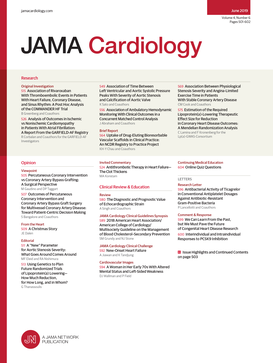Leveraging Preexisting Cardiovascular Data to Improve the Detection and Treatment of Hypertension
IF 14.8
1区 医学
Q1 CARDIAC & CARDIOVASCULAR SYSTEMS
引用次数: 0
Abstract
ImportanceHypertension is often underrecognized, leading to preventable morbidity and mortality. Tailored data systems combined with care augmented by trained nonphysicians have the potential to improve cardiovascular care.ObjectiveTo determine whether previously collected cardiovascular imaging data could be harnessed to improve the detection and treatment of hypertension through a system-level intervention.Design, Setting, and ParticipantsThe NOTIFY-LVH trial was a 2-arm, pragmatic randomized clinical trial conducted from March 2023 through June 2024 within the Mass General Brigham health care system, a multi-institutional network serving the greater Boston, Massachusetts, area. The study included individuals with a Mass General Brigham primary care affiliation who had left ventricular hypertrophy (LVH) on a prior echocardiogram, had no established cardiomyopathy diagnosis, and were not being treated with antihypertensive medications. Patients were followed for 12 months postintervention.InterventionPopulation health coordinators contacted clinicians of patients randomized to the intervention, notifying them of LVH and offering assistance with follow-up care. A clinical support pathway—including 24-hour ambulatory blood pressure monitoring or cardiology referrals—was provided to aid LVH evaluation.Main Outcomes and MeasuresThe primary outcome was the initiation of an antihypertensive medication. Secondary outcomes included new hypertension and cardiomyopathy diagnoses.ResultsA total of 648 patients were randomized—326 to the intervention and 322 to the control. Mean (SD) patient age was 59.4 (10.8) years and 248 patients (38.3%) were female. A total of 102 patients (15.7%) had a baseline diagnosis of hypertension and 109 patients (20.1%) had a mean outpatient blood pressure of 130/80 mm Hg or higher. Over 12 months, 53 patients (16.3%) in the intervention arm were prescribed an antihypertensive medication vs 16 patients (5.0%) in the control arm (adjusted odds ratio [OR], 3.76; 95% CI, 2.09-6.75;利用已有的心血管数据改进高血压的检测和治疗
本文章由计算机程序翻译,如有差异,请以英文原文为准。
求助全文
约1分钟内获得全文
求助全文
来源期刊

JAMA cardiology
Medicine-Cardiology and Cardiovascular Medicine
CiteScore
45.80
自引率
1.70%
发文量
264
期刊介绍:
JAMA Cardiology, an international peer-reviewed journal, serves as the premier publication for clinical investigators, clinicians, and trainees in cardiovascular medicine worldwide. As a member of the JAMA Network, it aligns with a consortium of peer-reviewed general medical and specialty publications.
Published online weekly, every Wednesday, and in 12 print/online issues annually, JAMA Cardiology attracts over 4.3 million annual article views and downloads. Research articles become freely accessible online 12 months post-publication without any author fees. Moreover, the online version is readily accessible to institutions in developing countries through the World Health Organization's HINARI program.
Positioned at the intersection of clinical investigation, actionable clinical science, and clinical practice, JAMA Cardiology prioritizes traditional and evolving cardiovascular medicine, alongside evidence-based health policy. It places particular emphasis on health equity, especially when grounded in original science, as a top editorial priority.
 求助内容:
求助内容: 应助结果提醒方式:
应助结果提醒方式:


